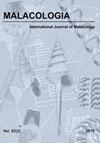Stable Isotopes Reveal Algal Assimilation in the Carnivorous Sea Slug Pleurobranchaea maculata (Quoy & Gaimard, 1832) on Patagonian Coasts
IF 1
4区 生物学
Q4 ZOOLOGY
引用次数: 0
Abstract
ABSTRACT Exotic species that achieve successful invasions often show considerable dietary plasticity in resource choice, sometimes adjusting their diet to new or variable resources. This can increase species' impact in the recipient environment. In this study, we explore the diet of the invasive gray side-gilled sea slug Pleurobranchaea maculata (Quoy & Gaimard, 1832) in two environments with contrasting presence of algae (different depths) on northern Patagonian coasts, by means of stable isotope analysis. Results showed the most probable prey contribution to the diet of shallow individuals of P. maculata to be algae, whereas colonial tunicates were the preferred prey in deep environments. Therefore, we suggest that P. maculata behaves as an omnivorous species in the receiving community, because it consumes and assimilates the algae, which represents a dietary shift compared to their original feeding habits (carnivorous). This species exhibited the ability to adapt to different dietary resources by showing significant differences in niche locations, niche breadth, and exhibiting little to no overlap between different environments, which supports the previous description of P. maculata as a generalist consumer. Pleurobranchaea maculata's dietary plasticity might drive ecological consequences in the invaded community. Thus, it is important to monitor for future changes in the benthic community to develop efficient programs for the management of this invasive voracious species.稳定同位素揭示了巴塔哥尼亚海岸食肉海蛞蝓Pleurobranchaea maculata (Quoy & Gaimard, 1832)中藻类的同化
摘要成功入侵的外来物种在资源选择方面往往表现出相当大的饮食可塑性,有时会根据新的或可变的资源调整饮食。这会增加物种对受体环境的影响。在这项研究中,我们通过稳定同位素分析,在巴塔哥尼亚北部海岸存在藻类(不同深度)的两种环境中,探索了入侵性灰侧鳃海蛞蝓斑胸蛙(Quoy&Gaimard,1832)的饮食。结果表明,斑蛙浅层个体的饮食中最有可能的猎物是藻类,而群落被膜虫是深部环境中的首选猎物。因此,我们认为斑蛙在接受群落中表现为杂食性物种,因为它消耗和同化藻类,这代表着与它们最初的食性(肉食性)相比,饮食发生了变化。该物种表现出适应不同饮食资源的能力,表现出生态位位置、生态位宽度的显著差异,并且在不同环境之间几乎没有重叠,这支持了之前对斑蛙作为多面手消费者的描述。斑胸兰的饮食可塑性可能会导致入侵群落的生态后果。因此,重要的是监测底栖生物群落的未来变化,以制定有效的计划来管理这种入侵性的贪婪物种。
本文章由计算机程序翻译,如有差异,请以英文原文为准。
求助全文
约1分钟内获得全文
求助全文
来源期刊

Malacologia
生物-动物学
CiteScore
2.00
自引率
0.00%
发文量
15
审稿时长
3 months
期刊介绍:
Malacologia publishes papers on all groups of the Mollusca. Malacologia specializes in publishing long papers and monographic treatments. Complete data are especially appreciated. Papers must be of interest to an international readership. Papers in systematics, ecology, population ecology, genetics, molecular genetics, evolution and phylogenetic treatments are especially welcomed. Also welcomed are letters to the editor involving papers published or issues of import to science of the day.
 求助内容:
求助内容: 应助结果提醒方式:
应助结果提醒方式:


